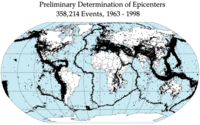
Photo from wikipedia
Abstract Muddy, upslope-migrating sediment waves, with their crestal lines parallel to the bathymetric contours, are the dominant geomorphic elements in the entire lower slope along the Indian north-eastern continental margin.… Click to show full abstract
Abstract Muddy, upslope-migrating sediment waves, with their crestal lines parallel to the bathymetric contours, are the dominant geomorphic elements in the entire lower slope along the Indian north-eastern continental margin. Wave dimensions are maximum with high but differing degrees of sediment accretions on the upslope and downslope sides of wave crests and with most upslope wave migrations in the northeastern part of the study area, having relatively low seafloor gradients. The wave dimensions decrease with lower as well as differing degrees of sediment accretions on both sides of wave crests and with lower upslope wave migrations in the southwestern parts of the study area, having steeper seafloor gradients. Within each area of the lower slope, starting from updip, wave dimensions increase to their maximum at some distance downdip with optimal low seafloor gradients. Farther downdip, the wave dimensions decrease even with lower seafloor gradients continuing. Also, within each area, at the base of the wave intervals, the waves are small and grow into larger features with more sediment accretions in the upper intervals. The distribution and characteristics of sediment waves observed along the Indian margin are indicative of deposition by down-slope moving, unconfined turbidity currents that have evolved from other sediment gravity flows derived from several point sources updip. Along-slope bottom currents are least likely agents of wave deposition here. We interpret that the spatial and temporal variations in wave dimensions are due to the variations in seafloor gradients, turbidity current flow characteristics, frequency, duration and total number of flow events in space and time.
Journal Title: Marine Geology
Year Published: 2021
Link to full text (if available)
Share on Social Media: Sign Up to like & get
recommendations!